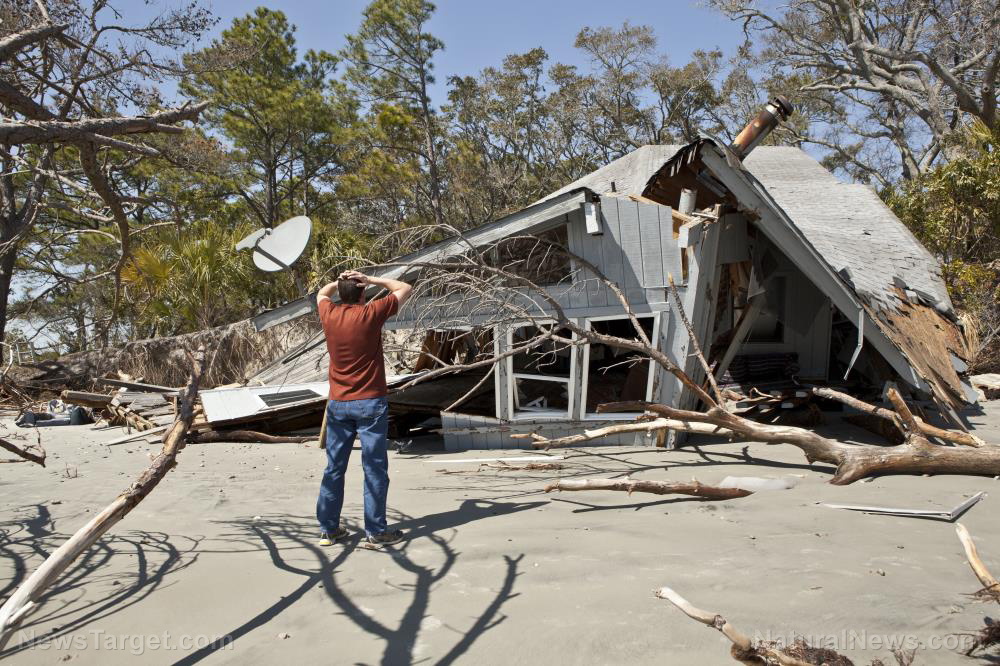 Parler
Parler Gab
Gab
Monitor what’s happening nearby
If you live in a state like California, check local news and other sources of information that discuss fires and other common natural disasters that could affect your homestead. If possible, subscribe to phone notifications from the local sheriff’s department. Taking these precautions can give you a heads-up when there is a fire or mudslide nearby so you can get ready while it's still miles from your property. With these early warnings, you can assess your plan and see if you need to take action immediately or if you just have to stay alert to safely deal with an emergency.Fortify your barn and outbuilding
Before SHTF, here are some things to do to keep your animals safe before, during and after an emergency scenario:- Give all animals durable and visible identification.
- Give poultry access to high perches if their coop is in a flood-prone area. Don't forget to leave them food and clean water above the potential flood line.
- Reinforce your house, barn and outbuildings with hurricane straps and other measures.
- Perform regular safety checks on all utilities, and include all buildings and facilities on your property.
Find a safe place to take your livestock
Look for a safe place to take your livestock if bringing them with you when you bug out is not an option. Many local fairgrounds will open their facilities for farmers to bring evacuated livestock. Sometimes veterinarians and kennels will accept evacuated animals during an emergency. Look for a local homesteading group. Talk to the members and make plans to offer a safe space for animals, trailers and RVs to help each other during fire season. (Related: Bug out survival planning: How to get out of the city after SHTF.) Alternatively, if you are worried about a fire sweeping through your area, make plans to evacuate your animals early to a place far from the danger zone. This could give you peace of mind, especially if you only have space in your car for your family and pets. If you want to transport your animals, you will need a trailer. You will also need pens that you can secure into the back of a truck, or crates that can hold your livestock. If you have a lot of animals, talk to your friends so you can borrow their trailers.Prepare a plan for last-minute homestead evacuation
In a worst-case scenario, the fire may be approaching fast and you may not be able to load up all your animals in time. Make sure you have trailers and trucks close to the livestock area for quick evacuation. If you think you may need to evacuate, gather your livestock in the smallest area possible for easy loading. This means if your chickens are normally free-range, keep them contained in a yard around their coop so it will be easier to catch them. Close off the gates to the larger pastures and contain other livestock in the area closest to the trailers. When you have the time, practice loading up with your livestock. This can help prepare your animals get used to being loaded, making them less likely to panic and become aggressive. Practicing will also help you figure out which animals are going to be the most uncooperative. Lastly, it will also help you estimate how much time you need to secure your animals. Prepare blinders, like a piece of cloth or a fabric bag. If some of the animals are panicking, it can be easier to lead them out if they have blinders on and can’t see the threat. Blinders are often used on horses, but you can use them on skittish cows and goats too. If there is a threat like a nearby fire, animals are more likely to panic due to fear. This means it might you much longer to load them up.Have a backup plan if you can’t evacuate the livestock
If you don't have time to load all your animals, turn them loose so they have a chance at escaping the flames. This isn't ideal, but if it's too dangerous and your family is at risk of dying in the fire, you will have to leave your livestock behind when you evacuate. Hopefully you won't have to do this, but you should prepare yourself for a similar emergency scenario. Prepare your homestead evacuation plan before SHTF so you know how to evacuate with your family and livestock on your farm or homestead. Watch the video below to learn how to feed your animals for free. This video is from the Perma Pastures Farm channel on Brighteon.com.More related stories:
Basic survival and prepping skills that your kids should learn ASAP. Survival 101: How to prepare for and survive a tornado. Survival 101: How to protect your family during civil war. Sources include: TheOrganicPrepper.com HumaneSociety.org Brighteon.comRIGGED: Medical company DocGo awarded $432M contract to bus illegals out of Big Apple
By Ramon Tomey // Share
Nearly 800,000 Californians behind on rent, with over $5B accumulated rental debts
By Arsenio Toledo // Share
Fraud alert: How to avoid common online scams
By Zoey Sky // Share
European security officials claim Putin appeared indecisive in first hours of Wagner Group rebellion
By Laura Harris // Share
How to spot and avoid FRAUDSTERS and SCAMMERS after a DISASTER
By Olivia Cook // Share
Governments continue to obscure COVID-19 vaccine data amid rising concerns over excess deaths
By patricklewis // Share
Tech giant Microsoft backs EXTINCTION with its support of carbon capture programs
By ramontomeydw // Share
Germany to resume arms exports to Israel despite repeated ceasefire violations
By isabelle // Share










